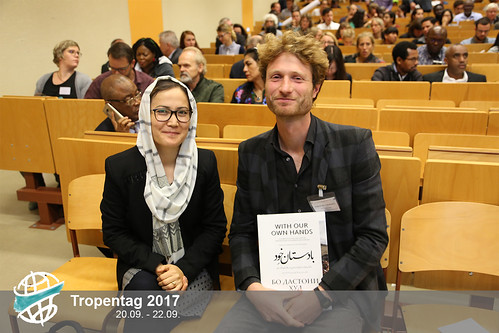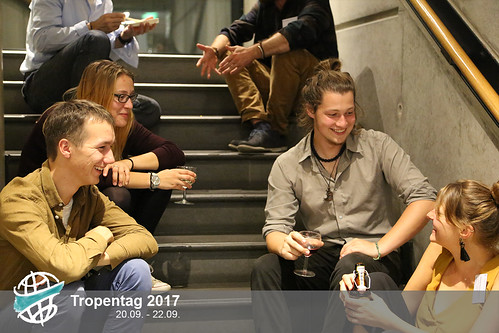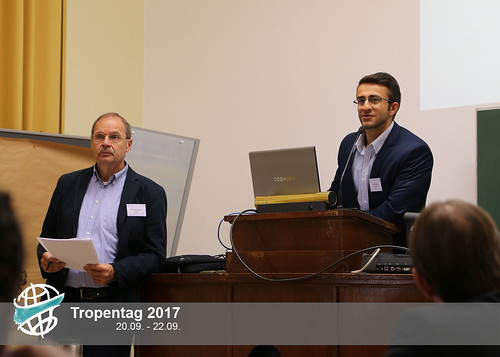Blogs
A Changing Environment Changing Lives
Sun, 09/24/2017 - 13:06 — giulia.rotanodariIn many countries, migration is a growing phenomenon because of political, economic and environmental reasons. In the last few decades, sudden or long-term changes in the environment are further exacerbating the often already precarious conditions in Sub-Saharan Africa, shaping the livelihoods of subsistence farmers in particular. This is shown by a study conducted in Ethiopia by Juliane Groth, from the Helmholtz Centre for Environmental Research (UFZ) during the "Institutions and Livelihood" oral presentation session .
By analyzing the reasons that force rural people to migrate, Groth found that this phenomenon is strongly linked to land degradation and shifts in rainfall seasonality. These are the drivers of the decline in livestock quantity and agricultural production. As a result, farmers are looking for fast growing crop varieties that allow for cultivation in a shortened rainy season.
Groth's study is evidence of the need for global intervention with programs to mitigate the impacts of climate change, especially by working with farmers to develop and introduce faster growing crops.
It's All About the Genes
Sun, 09/24/2017 - 12:23 — kristianj71I’m preaching to the choir, but to repeat for the nth time, climate change promises greater weather unpredictability and extreme temperatures worldwide. One strategy to mitigate the impact lies in mining genetic resources, gene banks and land races, for useful plant characteristics.
Farmers for thousands of years have carefully selected plants best fit to withstand the harsh environments found on their fields. This led to breathtaking genetic variety, as each field has its own unique microclimate. The resulting land races, often ignored due to their lower productivity, are an unexploited resource that could yield tomorrow’s answers. Dr. Mathias Wissuwa of JIRCAS in his oral presentation in “Genetic Resources and Abiotic Stresses” emphasized the need to tap the hidden genetic potential in land races and gene bank accessions.
Advances in genome sequencing technologies have lowered costs to a point where thousands of gene bank accessions can be mapped to find rare alleles that could enhance nutrient capture, or increased tolerance to drought. Once identified, market assisted selection (MAS) can be used to improve the crop. IRRI used this method to first identify the SUB1 gene, which gives flood tolerance, and then breed it into commonly grown varieties, creating ‘scuba’ rice. Dr. Wissuwa and JIRCAS has made promising headway in identifying a gene that promotes crown root growth to increase nutrient capture efficiency of zinc and phosphorous. At the end of his presentation, he went to great lengths to stress MAS had nothing to do with GMOs.
Moving Pictures
Fri, 09/22/2017 - 13:04 — schumacherlydiaInstead of presenting another powerpoint, Frederik van Oudenhoven impressed the audience with his moving pictures - a movie about the villages of the Pamir Mountains in Afghanistan and Tajikistan. This vivid movie not only touched me, but the majority of the audience, measured by the loud and lasting applause afterwards.

The Dutch film maker and biologist has devoted the last few years to understanding, preserving and publishing the traditional knowledge of people living in the isolated villages around the Afghan-Tajikistan border. Instead of focusing on the numbers of unemployed, undernourished and illiterate, he turned the camera to not only stunning landscapes but agricultural production, food processing, food culture and the people behind each stage. Further, he emphasized the beauty of diversity, whether it was biodiversity or cultural diversity. His film suggest with the loss of diversity we also lose beauty.
An Apology Poem to Institutions and Livelihoods
Fri, 09/22/2017 - 12:36 — megreslerYes, I attended Oral four in LH8.
My attention, I'll admit, truly a sad state.
Would you mind just looking on Twitter?
That global forum clogged with litter.
Let's move to Plenary 2, lest we be late.
Malnutrition in Africa: Oh, the Irony!
Fri, 09/22/2017 - 12:05 — lizkusiaIt is 8:00 a.m. and I am already at the Agrobiodiversity and Nutrition diversity poster session. Today, I am doubling as a student reporter and a poster presenter. The room is filled with enthusiastic faces, hungry for information on the topic. The session started on high note with a presentation on potato farming in Peru. However, something caught my eye throughout the presentations. All the other topics, including mine were about Africa. One of the speakers swept me away with his research on biofortification of cassava. This is good news! However, allow me to talk about the other side of the story.

Value Chains are Valuable
Fri, 09/22/2017 - 11:38 — Hana KhanhValue chains is the hot topic currently in agricultural economics. As a result, not surprisingly, many people came to the poster session, although it was organized very late in the afternoon of the second day, just before the biggest event of the conference, the "Gala dinner’’.

This year, there were up to 15 posters registered, and they had only one hour to present their work. I felt very positive as I learned about the many attempts to find the bottlenecks in the value chains of tropical and sub-tropical products in developing countries, perhaps leading to new suggestions and solutions for farmers. While Sham UI Haq and Yee Mon Aung worked on rice and pulses in Myanmar, Hazal Akcakara from the University of Bonn, evaluated the impact of sustainability certification on palm oil.
Silly Q&A at the "Social Event at Haus der Geschichte"
Fri, 09/22/2017 - 10:35 — kristianj71
The conference was nearly over, and it was time to celebrate. I walked around the room and asked a few silly questions (and some serious), many of which were collected from around the room. Enjoy!
What livestock animal would you be? Why?
A grass-fed milk cow in an agroforestry system in Columbia. –S.S.
A bull in a cattle herd in Switzerland. I could go everywhere in the pastures in the mountains. It would be a Demeter farm so I would hopefully live longer.-Dr. Christoph Reiber, Uni Hohenheim
I would be a rabbit because I am so fertile. –Anonymous
What’s the difference between a crocodile and an alligator?
The teeth…the size in general, the ecosystem… -Baldur Janz, IMK-IFU
One you see in a while, and the other later.- Jessica Lloyd (the creator of the joke), Uni Hohenheim
When you started (MSc. or PhD) what did you think you would be after?
Hmmm, nothing exciting, a professor teaching at the academy. I didn’t expect to be in agriculture. Back then I was only focused on biology. -Dr. Alejandro Pieters, Venezuelan Instititute for Scientific Research
Qui est ce qui est jaunes et qui attend?
Rethinking the Way We Farm
Fri, 09/22/2017 - 10:04 — mustamin.fadliKeynote speaker Bina Agarwal, Professor of Development Economics and Environment at the Global Development Institute, University of Manchester, elaborates on the three areas, or pillars, any pathway towards a future agriculture needs to address. In the first video, Professor Agarwal provides an overview of her three pillars, technology, ecology, and institutions.
In the second video, she describes in more detail group farming as a promising institutional innovation.





